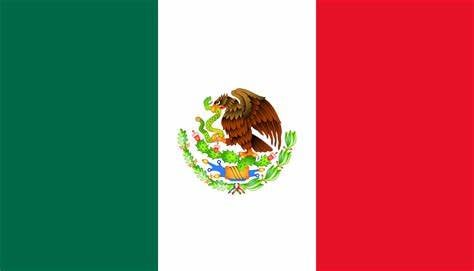This nation is in Vacation Mode for the next 881 turns. This nation cannot be attacked or traded with during that time.
| National Factbook |
| Flag: |

|
| Nation Name: |
United Mexican States |
| Leader Name: |
Sean Jose |
| Currency: |

Mexican Peso |
| National Animal: |

Golden eagle |
| History: |
Mexico gained independence from Spain in 1821, after a prolonged struggle marked by the Mexican War of Independence. The country faced numerous challenges in the 19th century, including regional conflicts, caudillo power struggles, the Mexican–American War, and foreign interventions like the French invasion. Efforts at modernization during La Reforma included promoting civil liberties and the separation of church and state, but the country was still beset by internal strife and external threats, including the Second Mexican Empire.
The late 19th-century Porfiriato era brought economic growth but also authoritarianism and social inequality, which eventually fueled the Mexican Revolution in 1910. The revolution led to significant social and political changes, with the emergence of the Institutional Revolutionary Party (PRI) as the dominant force. Throughout the 20th century, Mexico implemented land reforms, nationalized key industries, and expanded social welfare, but these achievements were marred by corruption, violence, and economic crises.
In the 1980s and 1990s, Mexico shifted towards privatization and trade liberalization, culminating in the signing of the North American Free Trade Agreement (NAFTA) in 1994. The turn of the century marked a significant shift in Mexico's political landscape, with the opposition National Action Party (PAN) winning the presidency in 2000, ending the PRI's long-standing dominance and ushering in a new era of Mexican politics. The 21st century has seen economic disparities, drug-related violence, and corruption. Administrations have focused on addressing these issues, with mixed success. The election of Andrés Manuel López Obrador in 2018 marked another significant shift, as his government has aimed to combat corruption, reduce inequality, and address the violence that has plagued the country for decades. |
| Geography |
| Continent: |
North America |
| Land Area: |
51,177.01 sq. km |
| Terrain: |
The geography of Mexico describes the geographic features of Mexico, a country in the Americas. Mexico is located at about 23° N and 102° W in the southern portion of North America. From its farthest land points, Mexico is a little over 3,200 km (2,000 mi) in length. Mexico is bounded to the north by the United States (specifically, from west to east, by California, Arizona, New Mexico, and Texas), to the west and south by the Pacific Ocean, to the east by the Gulf of Mexico, and to the southeast by Belize, Guatemala, and the Caribbean Sea. The northernmost constituent of Latin America, it is the most populous Spanish-speaking country in the world. Mexico is the world's 13th largest country, three times the size of Texas.
Beginning approximately 50 kilometres (31 mi) from the United States border, the Sierra Madre Occidental mountain range extends about 1,250 kilometres (780 mi) south to the Río Santiago, where it merges with the Cordillera Neovolcánica range that runs east–west across central Mexico. The Sierra Madre Occidental lies approximately 300 kilometres (190 mi) inland from the west coast of Mexico at its northern end but approaches to within fifty kilometers of the coast near the Cordillera Neovolcánica. The northwest coastal plain is the name given the lowland area between the Sierra Madre Occidental and the Gulf of California. The Sierra Madre Occidental averages 2,250 metres (7,380 ft) in elevation, with peaks reaching 3,000 metres (9,800 ft).
Iztaccíhuatl mountain near Mexico City. It is characterized by its snow-capped summit and rugged terrain, including steep slopes and glaciers. Pico de Orizaba, also known as Citlaltépetl, is the highest mountain in Mexico and the third highest peak in North America, after Denali in Alaska and Mount Logan in Canada.
The Sierra Madre Oriental mountain range starts at the Big Bend region of the border with the U.S. state of Texas and continues 1,350 kilometres (840 mi) until reaching Cofre de Perote, one of the major peaks of the Cordillera Neovolcánica. As is the case with the Sierra Madre Occidental, the Sierra Madre Oriental comes progressively closer to the coastline as it approaches its southern terminus, reaching to within 75 kilometres (47 mi) of the Gulf of Mexico. The northeast coastal plain extends from the eastern slope of the Sierra Madre Oriental to the Gulf of Mexico. The median elevation of the Sierra Madre Oriental is 2,200 metres (7,200 ft), with some peaks at 3,000 metres (9,800 ft).
The Mexican Altiplano, stretching from the United States border to the Cordillera Neovolcánica, occupies the vast expanse of land between the eastern and western sierra madres. A low east–west range divides the altiplano into northern and southern sections. These two sections, previously called the Mesa del Norte and Mesa Central, are now regarded by geographers as sections of one altiplano. The northern altiplano averages 1,100 meters in elevation and continues south from the Río Bravo del Norte through the states of Zacatecas and San Luis Potosí. Various narrow, isolated ridges cross the plateaus of the northern altiplano. Numerous depressions dot the region, the largest of which is the Bolsón de Mapimí. The southern Altiplano is higher than its northern counterpart, averaging 2,000 metres (6,600 ft) in elevation. The southern altiplano contains numerous valleys originally formed by ancient lakes. Several of Mexico's most prominent cities, including Mexico City and Guadalajara, are located in the valleys of the southern Altiplano. |
| Highest Peak: |
Pico de Orizaba,
5 meters
|
| Lowest Valley: |
,
0 meters
|
| Climate: |
The climate of Mexico is very diverse. The Tropic of Cancer effectively divides the country into temperate and tropical zones. Land that is north of the twenty-fourth parallel experiences lower temperatures during the winter months. South of the twenty-fourth parallel, temperatures are fairly consistent all year round and vary solely as a function of elevation. The north of the country usually receives less precipitation than the south.
Areas south of the twenty-fourth parallel with elevations up to 1,000 meters (3,281 ft) (the southern parts of both coastal plains as well as the Yucatán Peninsula), have a desert climate and a yearly median temperature between 24 and 28 °C (75.2 and 82.4 °F). Temperatures here remain high throughout the year, with only a 5 °C (9 °F) difference between winter and summer median temperatures. Although low-lying areas north of the twenty-fourth parallel are hot and humid during the summer, they generally have lower yearly temperature averages (from 20 to 24 °C or 68.0 to 75.2 °F) because of more moderate conditions during the winter.
Between 1,000 and 2,000 meters (3,281 and 6,562 ft), one encounters yearly average temperatures between 16 and 20 °C (60.8 and 68.0 °F). Towns and cities at this elevation south of the twenty-fourth parallel have relatively constant, pleasant temperatures throughout the year, whereas more northerly locations experience sizeable seasonal variations. Above 2,000 meters (6,562 ft), temperatures drop as low as an average yearly range between 8 and 12 °C (46.4 and 53.6 °F) in the Cordillera Neovolcánica. At 2,300 meters (7,546 ft), Mexico City (primarily subtropical highland climate) has a yearly median temperature of 15 °C (59 °F) with pleasant summers and mild winters. The city's daily highs and lows for May, its warmest month, average at 26 and 12 °C (78.8 and 53.6 °F), while for January, its coldest month, at 19 and 6 °C (66.2 and 42.8 °F) |
| People & Society |
| Population: |
935,525 people |
| Demonym: |
Mexican |
| Demonym Plural: |
Mexicans |
| Ethnic Groups: |
Mestizo - 62.8%
Amerindians - 21.0% |
| Languages: |
Mexican Spanish - 99.0% |
| Religions: |
Catholicism - 78.0% |
| Health |
| Life Expectancy: |
74 years |
| Obesity: |
32.4% |
| Alcohol Users: |
66.5% |
| Tobacco Users: |
13% |
| Cannabis Users: |
2% |
| Hard Drug Users: |
0% |
| Economy |
| Description: |
Economy of Mexico
The economy of Mexico is a developing mixed-market economy. It is the 12th largest in the world in nominal GDP terms and by purchasing power parity as of 2024. Since the 1994 crisis, administrations have improved the country's macroeconomic fundamentals. Mexico was not significantly influenced by the 2002 South American crisis, and maintained positive, although low, rates of growth after a brief period of stagnation in 2001. However, Mexico was one of the Latin American nations most affected by the 2008 recession with its gross domestic product contracting by more than 6% in that year. Among OECD nations, Mexico has a fairly strong social security system; social expenditure stood at roughly 7.5% of GDP.
The economy contains rapidly developing modern industrial and service sectors, with increasing private ownership. Recent administrations have expanded competition in ports, railroads, telecommunications, electricity generation, natural gas distribution and airports, with the aim of upgrading infrastructure. |
| Average Yearly Income: |
$157.17 |
| Gross Domestic Product (GDP): |
$1,284,186,917.00 |
| GDP per Capita: |
$1,372.69 |
| Gross National Income (GNI): |
$434,397,450.00 |
| Industries: |
Mexico's main sources of income and industries are the manufacturing sector, remittances from Mexican migrants abroad, the tourism industry, and oil exports from Petróleos Mexicanos. Sales from oil account for nearly a third of all government revenue, while remittances from Mexican immigrants in the United States to their families back home are a major source of income in Mexico, second only to oil and surpassing even the tourism industry. The Federal government of Mexico derived the largest share of its revenue from non-oil sources throughout the whole period under consideration, such as taxes and state-owned enterprises. |
| Military |
| History: |
The Mexican Armed Forces (Spanish: Fuerzas Armadas de México) are the military forces of the United Mexican States. The Spanish crown established a standing military in colonial Mexico in the eighteenth century. After Mexican independence in 1821, the military played an important political role, with army generals serving as heads of state. Following the collapse of the Federal Army during the 1910–1920 Mexican Revolution, former revolutionary generals systematically downsized the size and power of the military.
The Mexican military forces are composed of two independent entities: the Mexican Army and the Mexican Navy. The Mexican Army includes the Mexican Air Force, while the Mexican Navy includes the Naval Infantry Force (Marine Corps) and the Naval Aviation (FAN). The Army and Navy are controlled by two separate government departments, the National Defense Secretariat and the Naval Secretariat, and maintain two independent chains of command, with no joint command except the President of Mexico. |
| Soldiers: |
0 |
| Tanks: |
0 |
| Aircraft: |
0 |
| Ships: |
48 |
| Missiles: |
4 |
| Nuclear Weapons: |
0 |
| Last Updated: 08/29/2024 01:42 pm |













